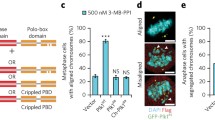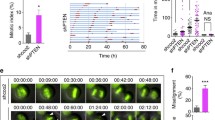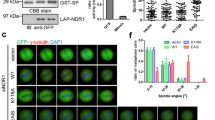Abstract
Polo-like kinase 1 (Plk1) is an essential mitotic regulator and undergoes periodic phosphorylation on threonine 210, a conserved residue in the kinase’s activation loop. While phosphate-mimicking alterations of T210 stimulate Plk1’s kinase activity in vitro, their effects on cell cycle regulation in vivo remain controversial. Using gene targeting, we replaced the native PLK1 locus in human cells with either PLK1 T210A or PLK1 T210D in both dominant and recessive settings. In contrast to previous reports, PLK1 T210D did not accelerate cells prematurely into mitosis, nor could it fulfill the kinase’s essential role in chromosome congression. The latter was traced to an unexpected defect in Plk1-dependent phosphorylation of BubR1, a key mediator of stable kinetochore–microtubule attachment. Using chemical genetics to bypass this defect, we found that Plk1T210D is nonetheless able to induce equatorial RhoA zones and cleavage furrows during mitotic exit. Collectively, our data indicate that K-fibers are sensitive to even subtle perturbations in T210 phosphorylation and caution against relying on Plk1T210D as an in vivo surrogate for the natively activated kinase.




Similar content being viewed by others
References
Ahonen LJ, Kallio MJ, Daum JR, Bolton M, Manke IA, Yaffe MB, Stukenberg PT, Gorbsky GJ (2005) Polo-like kinase 1 creates the tension-sensing 3F3/2 phosphoepitope and modulates the association of spindle-checkpoint proteins at kinetochores. Curr Biol 15:1078–1089
Archambault V, Glover DM (2009) Polo-like kinases: conservation and divergence in their functions and regulation. Nat Rev Mol Cell Biol 10:265–275
Berdougo E, Terret ME, Jallepalli PV (2009) Functional dissection of mitotic regulators through gene targeting in human somatic cells. Methods Mol Biol 545:21–37
Burkard ME, Randall CL, Larochelle S, Zhang C, Shokat KM, Fisher RP, Jallepalli PV (2007) Chemical genetics reveals the requirement for Polo-like kinase 1 activity in positioning RhoA and triggering cytokinesis in human cells. Proc Natl Acad Sci U S A 104:4383–4388
Burkard ME, Maciejowski J, Rodriguez-Bravo V, Repka M, Lowery DM, Clauser KR, Zhang C, Shokat KM, Carr SA, Yaffe MB, Jallepalli PV (2009) Plk1 self-organization and priming phosphorylation of HsCYK-4 at the spindle midzone regulate the onset of division in human cells. PLoS Biol 7:e1000111
Chan EH, Santamaria A, Sillje HH, Nigg EA (2008) Plk1 regulates mitotic Aurora A function through betaTrCP-dependent degradation of hBora. Chromosoma 117:457–469
Deming PB, Flores KG, Downes CS, Paules RS, Kaufmann WK (2002) ATR enforces the topoisomerase II-dependent G2 checkpoint through inhibition of Plk1 kinase. J Biol Chem 277:36832–36838
Elowe S, Hummer S, Uldschmid A, Li X, Nigg EA (2007) Tension-sensitive Plk1 phosphorylation on BubR1 regulates the stability of kinetochore microtubule interactions. Genes Dev 21:2205–2219
Fu Z, Malureanu L, Huang J, Wang W, Li H, van Deursen JM, Tindall DJ, Chen J (2008) Plk1-dependent phosphorylation of FoxM1 regulates a transcriptional programme required for mitotic progression. Nat Cell Biol 10:1076–1082
Jackman M, Lindon C, Nigg EA, Pines J (2003) Active cyclin B1-Cdk1 first appears on centrosomes in prophase. Nat Cell Biol 5:143–148
Jang YJ, Ma S, Terada Y, Erikson RL (2002) Phosphorylation of threonine 210 and the role of serine 137 in the regulation of mammalian polo-like kinase. J Biol Chem 277:44115–44120
Kang YH, Park JE, Yu LR, Soung NK, Yun SM, Bang JK, Seong YS, Yu H, Garfield S, Veenstra TD, Lee KS (2006) Self-regulated Plk1 recruitment to kinetochores by the Plk1-PBIP1 interaction is critical for proper chromosome segregation. Mol Cell 24:409–422
Kelm O, Wind M, Lehmann WD, Nigg EA (2002) Cell cycle-regulated phosphorylation of the Xenopus polo-like kinase Plx1. J Biol Chem 277:25247–25256
Kishi K, van Vugt MA, Okamoto K, Hayashi Y, Yaffe MB (2009) Functional dynamics of Polo-like kinase 1 at the centrosome. Mol Cell Biol 29:3134–3150
Lee KS, Erikson RL (1997) Plk is a functional homolog of Saccharomyces cerevisiae Cdc5, and elevated Plk activity induces multiple septation structures. Mol Cell Biol 17:3408–3417
Lenart P, Petronczki M, Steegmaier M, Di Fiore B, Lipp JJ, Hoffmann M, Rettig WJ, Kraut N, Peters JM (2007) The small-molecule inhibitor BI 2536 reveals novel insights into mitotic roles of polo-like kinase 1. Curr Biol 17:304–315
Li H, Liu XS, Yang X, Wang Y, Turner JR, Liu X (2010) Phosphorylation of CLIP-170 by Plk1 and CK2 promotes timely formation of kinetochore–microtubule attachments. EMBO J 29:2953–2965
Lindon C, Pines J (2004) Ordered proteolysis in anaphase inactivates Plk1 to contribute to proper mitotic exit in human cells. J Cell Biol 164:233–241
Liu X, Lei M, Erikson RL (2006) Normal cells, but not cancer cells, survive severe Plk1 depletion. Mol Cell Biol 26:2093–2108
Loncarek J, Hergert P, Khodjakov A (2010) Centriole reduplication during prolonged interphase requires procentriole maturation governed by Plk1. Curr Biol 20:1277–1282
Lowery DM, Lim D, Yaffe MB (2005) Structure and function of Polo-like kinases. Oncogene 24:248–259
Macurek L, Lindqvist A, Lim D, Lampson MA, Klompmaker R, Freire R, Clouin C, Taylor SS, Yaffe MB, Medema RH (2008) Polo-like kinase-1 is activated by aurora A to promote checkpoint recovery. Nature 455:119–123
Matsumura S, Toyoshima F, Nishida E (2007) Polo-like kinase 1 facilitates chromosome alignment during prometaphase through BubR1. J Biol Chem 282:15217–15227
Nishino M, Kurasawa Y, Evans R, Lin SH, Brinkley BR, Yu-Lee LY (2006) NudC is required for Plk1 targeting to the kinetochore and chromosome congression. Curr Biol 16:1414–1421
Oppermann FS, Grundner-Culemann K, Kumar C, Gruss OJ, Jallepalli PV, Daub H (2012) Combination of chemical genetics and phosphoproteomics for kinase signaling analysis enables confident identification of cellular downstream targets. Mol Cell Proteomics 11(O111):012351
Papi M, Berdougo E, Randall CL, Ganguly S, Jallepalli PV (2005) Multiple roles for separase auto-cleavage during the G2/M transition. Nat Cell Biol 7:1029–1035
Peschiaroli A, Dorrello NV, Guardavaccaro D, Venere M, Halazonetis T, Sherman NE, Pagano M (2006) SCFbetaTrCP-mediated degradation of Claspin regulates recovery from the DNA replication checkpoint response. Mol Cell 23:319–329
Petronczki M, Lenart P, Peters JM (2008) Polo on the rise—from mitotic entry to cytokinesis with Plk1. Dev Cell 14:646–659
Qi W, Tang Z, Yu H (2006) Phosphorylation- and polo-box-dependent binding of Plk1 to Bub1 is required for the kinetochore localization of Plk1. Mol Biol Cell 17:3705–3716
Qian YW, Erikson E, Maller JL (1999) Mitotic effects of a constitutively active mutant of the Xenopus polo-like kinase Plx1. Mol Cell Biol 19:8625–8632
Randall CL, Burkard ME, Jallepalli PV (2007) Polo kinase and cytokinesis initiation in mammalian cells: harnessing the awesome power of chemical genetics. Cell Cycle 6:1713–1717
Rieder CL (1981) The structure of the cold-stable kinetochore fiber in metaphase PtK1 cells. Chromosoma 84:145–158
Seki A, Coppinger JA, Du H, Jang CY, Yates JR 3rd, Fang G (2008a) Plk1- and beta-TrCP-dependent degradation of Bora controls mitotic progression. J Cell Biol 181:65–78
Seki A, Coppinger JA, Jang CY, Yates JR, Fang G (2008b) Bora and the kinase Aurora a cooperatively activate the kinase Plk1 and control mitotic entry. Science 320:1655–1658
Smits VA, Klompmaker R, Arnaud L, Rijksen G, Nigg EA, Medema RH (2000) Polo-like kinase-1 is a target of the DNA damage checkpoint. Nat Cell Biol 2:672–676
van de Weerdt BC, van Vugt MA, Lindon C, Kauw JJ, Rozendaal MJ, Klompmaker R, Wolthuis RM, Medema RH (2005) Uncoupling anaphase-promoting complex/cyclosome activity from spindle assembly checkpoint control by deregulating polo-like kinase 1. Mol Cell Biol 25:2031–2044
van Vugt MA, Bras A, Medema RH (2004) Polo-like kinase-1 controls recovery from a G2 DNA damage-induced arrest in mammalian cells. Mol Cell 15:799–811
Wong OK, Fang G (2005) Plx1 is the 3F3/2 kinase responsible for targeting spindle checkpoint proteins to kinetochores. J Cell Biol 170:709–719
Yamaguchi T, Goto H, Yokoyama T, Sillje H, Hanisch A, Uldschmid A, Takai Y, Oguri T, Nigg EA, Inagaki M (2005) Phosphorylation by Cdk1 induces Plk1-mediated vimentin phosphorylation during mitosis. J Cell Biol 171:431–436
Zhang W, Fletcher L, Muschel RJ (2005) The role of Polo-like kinase 1 in the inhibition of centrosome separation after ionizing radiation. J Biol Chem 280:42994–42999
Zhou T, Aumais JP, Liu X, Yu-Lee LY, Erikson RL (2003) A role for Plk1 phosphorylation of NudC in cytokinesis. Dev Cell 5:127–138
Acknowledgments
We thank Sabine Elowe and Erich Nigg for kindly providing the pS676-BubR1 antibody. This study was supported by grants from the American Cancer Society (114520-RSG-08-093-01-CCG) and National Institutes of Health (R01GM094972) to P.V.J.
Author information
Authors and Affiliations
Corresponding author
Additional information
Communicated by Erich Nigg
Electronic supplementary material
Below is the link to the electronic supplementary material.
Supplementary Figure 1
Verification of gene targeting. a Southern blot analysis confirmed recovery of clones with each of the desired genotypes. b RT-PCR analysis confirmed monoallelic expression of PLK1T210A and PLK1T210D after AdCre infection. (JPEG 41 kb)
Supplementary Figure 2
Time course of mitotic arrest and slippage in cells hemizygous for PLK1 T210A or PLK1 T210D. a Cells of the indicated genotypes were infected with AdCre and harvested 3 days laster. Nocodazole was added to the media 12 h prior to cell harvest. Lysates were probed with an antibody against Plk1. b Cells were collected 0, 1, 2, or 3 days after AdCre infection and scored based on nuclear morphology. At least 3 sets of 100 cells were counted for each timepoint. Error bars represent SEM. (JPEG 39 kb)
Supplementary Figure 3
Chemical genetics confirms that Plk1T210D is unable to support chromosome congression and satisfy the spindle checkpoint. a Chromosome alignment assay. Cells were released from a nocodazole block into medium containing 3-MB-PP1 and MG132. Two hours later, cells were fixed and stained with DAPI (blue), CREST antisera (red) and α-tubulin antibodies (green). At least 50 cells were scored per sample. Scale bar represents 10 μm. b Cells were treated with 3-MB-PP1 and nocodazole, then stained for S676-phosphorylated and total BubR1 as in Fig. 3a. c Cold stability of K-fibers in 3-MB-PP1 treated Plk1as/wt and Plk1as/T210D cells was determined as in Fig. 2e. d Time course of mitotic arrest and slippage after allelic-specific inhibition in Plk1as/T210D cells. Percentages of mitotic and micronucleated cells were determined from three sets of 100 cells each. Error bars represent SEM. e Wild type, T210D, or T210A Plk1 were immunoprecipitated from Plk1as/wt, Plk1as/T210D, and Plk1as/T210A cells using mCherry-specific antibodies, then incubated with casein and [γ-32P]ATP for the times indicated. Samples were resolved by SDS-PAGE and either processed for Coomassie staining and phosphorimager detection (top and middle rows) or blotted to detect Plk1 (bottom row). (JPEG 99 kb)
(AVI 3188 kb)
(AVI 3375 kb)
Rights and permissions
About this article
Cite this article
Paschal, C.R., Maciejowski, J. & Jallepalli, P.V. A stringent requirement for Plk1 T210 phosphorylation during K-fiber assembly and chromosome congression. Chromosoma 121, 565–572 (2012). https://doi.org/10.1007/s00412-012-0375-8
Received:
Revised:
Accepted:
Published:
Issue Date:
DOI: https://doi.org/10.1007/s00412-012-0375-8




